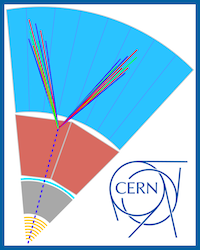Speaker
Description
Current searches for Long-Lived Particles (LLPs) and Feebly Interacting Particles (FIPs) face critical systematic limitations in collider detector geometries and cosmological analyses. At the LHC, experiments like ATLAS, CMS, and LHCb employ displaced vertex triggers that approximate detection efficiency with step functions, neglecting the probabilistic survival probability $P_{\text{surv}}(L) = e^{-L/\gamma c\tau}$ for decays occurring at radii $r$. This leads to overestimated sensitivity for long-lived states ($c\tau > 10$ m), particularly at ATLAS/CMS, where edge effects near muon chambers are unaccounted for. LHCb’s extended decay volume (12 m baseline) improves reach for $c\tau \sim 1$–$10$ m, but momentum-dependent vertex resolution degrades for high-mass LLPs ($m \gtrsim 10$ GeV), introducing $\mathcal{O}(30\%)$ uncertainties in mass reconstruction. Furthermore, material interactions from beam-gas collisions generate $\mathcal{O}(10^3)$ fake displaced vertices per fb$^{-1}$ at LHCb’s low-$p_T$ thresholds ($p_T > 0.5$ GeV), necessitating non-Poissonian background treatments. Meanwhile, cosmological constraints on MeV-scale FIPs decaying during the CMB epoch ($z \sim 10^6$) assume instantaneous energy deposition, overlooking time-integrated spectral distortions $\Delta \mu \propto \int \Gamma_{\text{dec}} e^{-\Gamma_{\text{dec}} t} dt$, which weaken limits for $c\tau \sim 10^{12}$ m by $\sim 50\%$. Non-thermal production mechanisms, such as $\phi \to \chi\chi$ during reheating, evade BBN bounds via $\Omega_{\chi} \propto T_{\text{reh}}^3/m_{\phi}$ dependencies, yet remain absent from joint collider-cosmology frameworks. Sub-GeV FIPs with nucleon couplings $g_n \sim 10^{-10}$ further blur boundaries between collider and direct detection exclusions, leaving $\mathcal{O}(1)$ gaps in $m_{\chi} \sim 100$ MeV parameter spaces. To resolve these gaps, we advocate for adaptive trigger strategies combining LHCb’s vertexing with ATLAS/CMS calorimeter timing ($\Delta t > 2$ ns), time-integrated cosmological likelihoods for $c\tau > 10^{10}$ m, and unified beam-gas background models across experiments. This synthesis underscores the need for detector-specific statistical frameworks and cross-disciplinary correlations to close the LLP/FIP discovery gap.
